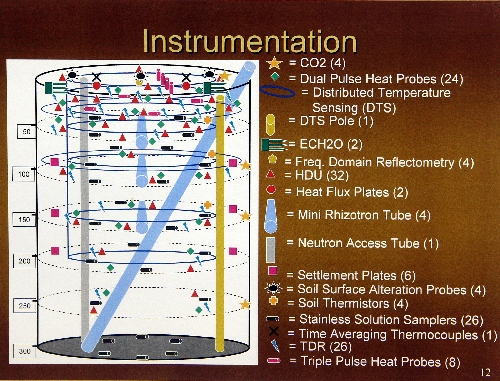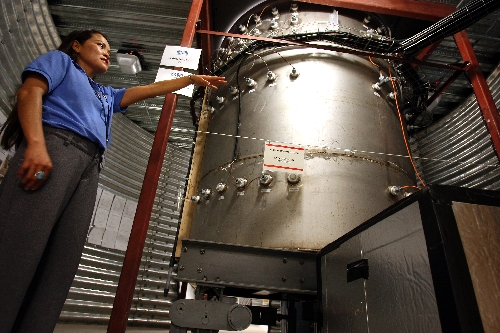Desert hydrologists go with the flow at tunnel project in Boulder City
They stand like three giant soup cans packed with tons of soil and balanced on beams in separate rooms at the bottom of a 15-foot-deep tunnel in Boulder City.
Protruding from fist-size portals on the sides of the 10-foot-tall steel cylinders are tubes and wires that give them an appearance of being on life support.
But these lysimeters, as scientists call them, are carefully engineered containers resting on scales so sensitive they can weigh a trace amount of rainfall or measure the slightest pull from the moon's gravity.
The project, launched more than two years ago by Desert Research Institute hydrologists, is designed to mimic conditions of the Mojave Desert from the surface down so they can watch and measure moisture as it seeps toward groundwater layers.
Fittingly, they have named the lysimeters after characters in the movie "The Matrix," which is about simulated reality created by computers. They are dubbed Neo, Trinity and Morpheus. A fourth lysimeter under development will be named Oracle.
The scientists hope to establish baseline information that climate scientists and other researchers can use to understand how fast and far and under what conditions precipitation from rain and snow travels through the subsurface.
This is of use to researchers who study climate change and water availability, and the results can be used by water planners.
This fall, scientists will plant creosote and white sage bushes atop the open cylinders to add the effects of plant life to the equation.
They are also preparing a fourth experiment in which a 10-foot-tall block of desert soil carved from the Eldorado Valley, south of Boulder City, will be hauled to the Desert Research Institute facility off Buchanan Boulevard and inserted into a rectangular steel box and lowered to a room at the end of the tunnel.
Like the cylinders, which are equipped with more than 160 sensors, the box is designed to make the same measurements of the natural, desert block for comparison with the baseline data from soil layers that were fashioned around diagnostic gear in the cylinders.
Michael Young, the principal investigator and interim director of DRI's Hydrological Sciences Division, patterned the project after one he developed at the University of Arizona. This one allows researchers to make direct measurements of runoff from rain and snow that recharges the groundwater.
"We're measuring how far water goes down and how much evaporates," he said after a conference with water supply managers last month.
Overall, in the grand scheme of climate change research by scientists worldwide, "this could be a calibration point for soil moisture content," Young said. The $3 million project is funded by a National Science Foundation grant.
In the span of 1½ years since July 2008, water from the first rain shower has traveled at a snail's pace, reaching a point only 2½ feet from the surface.
During a tour of the lysimeter facility Thursday, DRI hydrologist Karletta Chief explained how measurements are made and why the more than a dozen graduate and undergraduate scientists behind the project can attest to its accuracy for gauging moisture movement through desert soil in the arid Southwest.
Each cylinder is equipped with a system of fiber-optic coils that measures temperatures along every meter of soil. This allows the team to pinpoint where water evaporates as sunlight heats the desert floor and the air above it.
A series of metal plates attached to cables allows scientists to measure how much soil settles over time.
And, sensors that measure carbon dioxide will give the team insight into how much is retained in the soil and how much plants are breathing.
Rotating camera scanners are periodically inserted in diagonal and horizontal tubes to let scientists capture images of how soil particles and pore spaces are arranged. This allows them to track water movement and uptake by plant roots, said Chief, a postdoctoral fellow in charge of instrumentation and calibration.
Eventually, the team will be able to determine how much water goes into the soil, how much is evaporated and how much is used by plants.
"It's going to help us gain information for other researchers to improve their hydrologic models for predicting water availability in the desert," she said.
The team has documented two significant rain and snow events, including one in December 2008 that showed a sharp increase in the containers' weights.
Given the effect of evaporation that follows, Chief said the team realizes it's going to take "a very long time" for water to reach the bottom of the cylinders."
Similarly the team is getting a better idea of the role the desert plays in retaining carbon dioxide, a greenhouse gas given off from combustion of fossil fuels that many scientists believe is driving global warming.
"It's important on a global scale to see how carbon dioxide is increasing and being absorbed by the desert," Chief said.
Contact reporter Keith Rogers at krogers @reviewjournal.com or 702-383-0308.




















